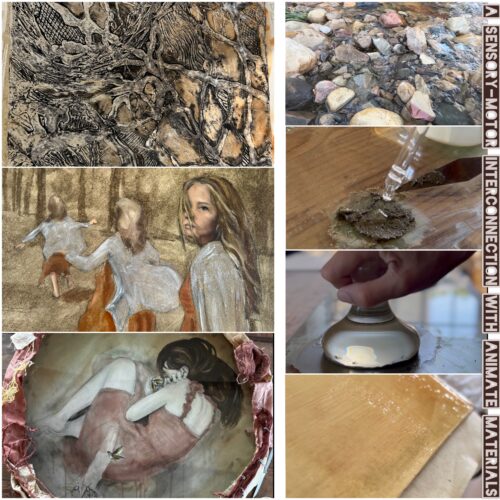
Pallant House gets thumbs up!

This is a post from the weareoca.com archive. Information contained within it may now be out of date.
It was a pleasant surprise for most of the students who visited Chichester on the 23 March to discover the elegant Queen Anne House and its superb collection of Twentieth Century Art, they had not been to Pallant House before. We had lunch in the cathedral café, and in the cathedral we saw works by John Piper, Graham Sutherland and Marc Chagall, which had been commissioned for the nave. The personal collection of Oliver Hussey, former bishop, which we looked at after lunch, included works by Cornwall-based artists such as Barbara Hepworth, Ben Nicholson, Christopher Wood and Terry Frost. There is also work from the 1960s by Peter Blake, Patrick Caulfield and Michael Andrews. These were a perfect complement to our visit to the exhibition of RB Kitaj’s work, exemplifying the crisis of representation that took place during that decade.
After leaving the Royal College in 1960, Kitaj, like his great friend Hockney, began to collage together seemingly unconnected images, abstract shapes and freely painted passages of paint. His fragmented compositions included references to philosophy, music and radical politics as well as to a growing interest in his Jewish background. His use of photographs taken from newspapers, films and popular culture recalls the work of Blake and Andrews. Their enigmatic nature was even more apparent in his screen prints where the opacity of the medium reinforces the deadpan quality of the works. Their cryptic nature is reminiscent both of Patrick Caulfield’s cool, tight-lipped realism and of the detachment of contemporary minimalism. 
From his training in Vienna, Kitaj acquired an interest in thinkers such as Jung and Walter Benjamin as well as a tendency to create decorative compositions full of his lyrical lines and sugary colours. All of these characteristics are apparent in his painting of Sergeant Cross, an imaginary hero of the Vietnam war, in which he combined obscure references to St John of the Cross with allusions to the oppression of women and racial minorities. Kitaj’s intellectualism and his magpie approach to art provoked a hostile response from critics. The accusations of pretentiousness and name-dropping that greeted his Tate retrospective in 1994 contributed first to his wife’s death from an aneurism and later to his own suicide in 2007. The group spent some time discussing to what extent Kitaj was ahead of his time in his preoccupation with meaning and image, his use of irony and his adoption of practices such as appropriation.
We then looked at an exhibition of hospital drawings that Barbara Hepworth had created during the 1950s in response to an invitation from a surgeon. After the messy discontinuities of Kitaj’s work, these seemed even more precise in their use of thinly drawn pencil lines and of a limited range of colours. The delicacy of the drawings seemed to equate the precision of the surgeon’s work with the careful deliberations of her art. One of the students pointed out the importance of their use of hardboard as a support, which increased the hard-won quality of the line and hence their similarity to etchings. We talked about the ritualistic nature of the operations that they described and the priest-like portrayal of the surgeons swathed in surgical scrubs so that only their hands and eyes were visible. Their anonymous sculptural figures were reminiscent of Henry Moore’s shelter drawings and we explored this comparison by talking about how Moore’s work expressed the solidarity of the nation during the second world war while Hepworth’s celebrated the communal virtues of the new National Health system. The latter was part of an extension of the state that included the creation of the Arts Council, the British Council and the commissioning of public art works in the new towns from which both she and Moore benefited.






The visit sounds wonderful – is the personal collection of the former bishop always open or did you make special arrangements to see it. I can’t find any details on the Cathedral web site
Many thanks Julia
Anyone wanting to read some scholarly work on Kitaj could do a lot worse than look at ‘Critical Kitaj: Essays on the Work of R. B. Kitaj’ edited by James Aulich et al. (if you can find a copy as it is out of print!)
I would be interested to know what came of the discussion on whether Kitaj was ahead of his time. He was quite an influence on many painters when I was at college in Edinburgh in the eighties. Younger Scottish artists like Stephen Campbell and Adrian Wisnieski, as well as German and Italian Transavanguard, added to the excitement of figurative painting which was still going strong in Scotland at the time. Figurative painting, although far from being in the limelight,has begun to peep out from behind the curtains again- perhaps a little shyly. I’m sure Kitaj will continue to be an influence.
I so happened to be in Birmingham (for the first time) the other day, having a day away from visiting relatives. At the City Museum and Art Gallery I was pleased to see one of Barbara Hepworth’s surgeon drawings. I think her daughter was in hospital at the time. I was impressed by the delicacy and power of the work, similar in essence but so different in detail from her sculptures.